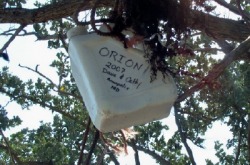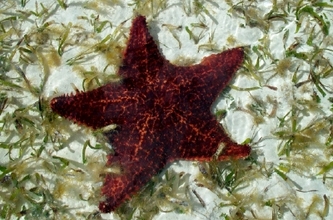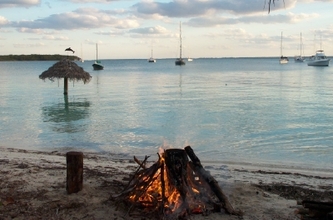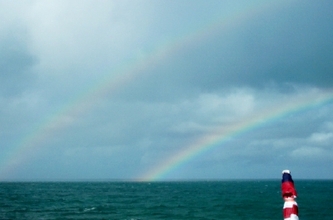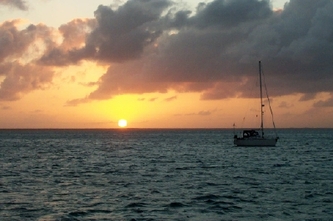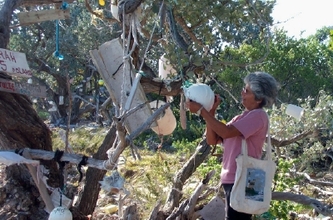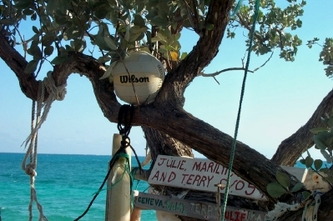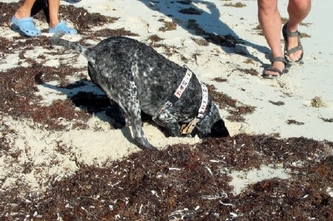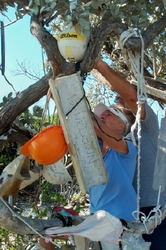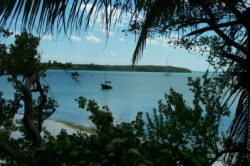
Manjack Cay
Manjack Cay
With a prolonged forecast of high winds, we decided to take advantage of a closing window of opportunity to cross through the Whale north to Manjack Cay on Thursday (March 15th). We had an easy passage and proceeded the short distance up to Manjack Cay, where we were to ride out the nasty weather forecast for the next week. The same weather was keeping Marianna and Merlin holed up in Georgetown (in the southern Bahamas) for much longer than they had wanted. Instead of joining us in the Abacos, they decided they needed to make a beeline for the states. So, we agreed to try to hook up with them at West End on Grand Bahama island and cross back together from there.
On Sunday, we managed to get a little exploring in on Manjack Cay before the weather forced us back on to the boat for several days. The same day, Bill and Leslie (the only long-term residents on Manjack Cay) hosted a bonfire for all of us cruisers in the harbor. We all brought h’or d’ouvres and something to drink and got to meet each other, as well as Bill and Leslie, their guests and Paul, a former cruiser who is building a place on Manjack.
With a prolonged forecast of high winds, we decided to take advantage of a closing window of opportunity to cross through the Whale north to Manjack Cay on Thursday (March 15th). We had an easy passage and proceeded the short distance up to Manjack Cay, where we were to ride out the nasty weather forecast for the next week. The same weather was keeping Marianna and Merlin holed up in Georgetown (in the southern Bahamas) for much longer than they had wanted. Instead of joining us in the Abacos, they decided they needed to make a beeline for the states. So, we agreed to try to hook up with them at West End on Grand Bahama island and cross back together from there.
On Sunday, we managed to get a little exploring in on Manjack Cay before the weather forced us back on to the boat for several days. The same day, Bill and Leslie (the only long-term residents on Manjack Cay) hosted a bonfire for all of us cruisers in the harbor. We all brought h’or d’ouvres and something to drink and got to meet each other, as well as Bill and Leslie, their guests and Paul, a former cruiser who is building a place on Manjack.
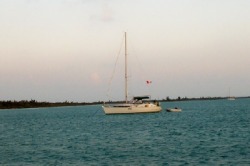
An oddity about our earlier than expected departure is that we now seem to be keeping company with a lot of boats that wintered in Georgetown. One of these is R Pelican, another Beneteau 36cc like ours. We got the tour of each others’ boats, comparing pluses and minuses and making notes for the changes we’d like in ours. Pat and Alex live in Canada, but leave their boat in the Chesapeake, so we hope to run into them again before they haul it out at the end of May and return to Ottawa.
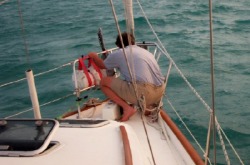
Blowin' In the Wind
When we heard the forecast of 25-30 knot winds for days on end, we kept hoping it was just an overly pessimistic forecast, which would be proved wrong. Unfortunately, they got this prediction right.
The first blow came Friday, just after arriving at Manjack -- all day and all night. The winds were blowing from the southwest and then clocking around to the northwest. These were the directions where we had no protection from the island. There were only 3 other boats in the anchorage for this reason. So, we gave ourselves a lot of room from the other boats and from shore to give us time to react if the anchor dragged. We also put out all of our chain (130’) and then waited for the winds to build and shift direction. The worst of it came Friday night as thunderstorms built to the north and west and finally came over us around midnight. The winds went up to 40 knots, the worst we’ve had on anchor. To ensure we could react if we started to drag, we started the engine and kept it running until the storm had passed and no others seemed imminent. We could see by the GPS track that we had moved back about 5 feet, whether due to drag or the stretching of the chain, we’re not sure. However, we held there and began to swing in the new pattern. The next day, the winds continued to shift until finally they started blowing from the north, giving us some protection from the island. The waves didn’t calm down for most of Saturday, so we were rolling a bit as they hit us at an angle to our beam.
After a beautiful day Sunday, the winds started again, building to over 30 knots on Thursday and rarely dropping below 20. Luckily this time, they were coming from E to NE, which is where the island provides the most protection. Although we could have anchored much closer to the protection of the island with these winds, we were reluctant to pull up our anchor which had been holding so well for so long. So, we decided to stay put and take a little more exposure in exchange for the secure knowledge that we were not likely to move. As an added precaution, we backed down on the anchor in the new direction to ensure it was set.
We had no more problems and were grateful when the winds finally began to subside on Friday.
When we heard the forecast of 25-30 knot winds for days on end, we kept hoping it was just an overly pessimistic forecast, which would be proved wrong. Unfortunately, they got this prediction right.
The first blow came Friday, just after arriving at Manjack -- all day and all night. The winds were blowing from the southwest and then clocking around to the northwest. These were the directions where we had no protection from the island. There were only 3 other boats in the anchorage for this reason. So, we gave ourselves a lot of room from the other boats and from shore to give us time to react if the anchor dragged. We also put out all of our chain (130’) and then waited for the winds to build and shift direction. The worst of it came Friday night as thunderstorms built to the north and west and finally came over us around midnight. The winds went up to 40 knots, the worst we’ve had on anchor. To ensure we could react if we started to drag, we started the engine and kept it running until the storm had passed and no others seemed imminent. We could see by the GPS track that we had moved back about 5 feet, whether due to drag or the stretching of the chain, we’re not sure. However, we held there and began to swing in the new pattern. The next day, the winds continued to shift until finally they started blowing from the north, giving us some protection from the island. The waves didn’t calm down for most of Saturday, so we were rolling a bit as they hit us at an angle to our beam.
After a beautiful day Sunday, the winds started again, building to over 30 knots on Thursday and rarely dropping below 20. Luckily this time, they were coming from E to NE, which is where the island provides the most protection. Although we could have anchored much closer to the protection of the island with these winds, we were reluctant to pull up our anchor which had been holding so well for so long. So, we decided to stay put and take a little more exposure in exchange for the secure knowledge that we were not likely to move. As an added precaution, we backed down on the anchor in the new direction to ensure it was set.
We had no more problems and were grateful when the winds finally began to subside on Friday.
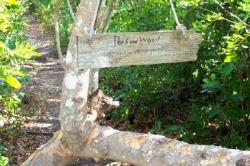
Poisonwood
On the path leading up to Nippers on Great Guana Cay, there is a tree with a sign attached, describing it as “Poisonwood”. All who pass are warned not to be tempted to climb it. Well, Dave didn’t climb it or even get near to it, but somewhere he managed to have a close encounter with some poisonwood, which developed into a rash on his leg, very similar to a typical poison ivy reaction, but much more ferocious. He doesn’t usually break out in this way, so we didn’t identify what the red spots were initially. Once we decided it was probably poisonwood, we looked for the remedies that we carried on board that might help. He started soaking it in Domeboro solution twice a day, which was keeping it in check, but wasn’t completely getting rid of it. We were also running out of this remedy, and it was obvious the rash needed more treatments than we would be able to give.
Then at the bonfire, we learned that a local remedy for poisonwood was Crystal solid deodorant. Leslie offered to let him have a chunk to use on his rash. This finally did the trick and the rash started subsiding. When we get back to the states we plan to add this to our medicine cabinet.
To express our gratitude, Cathy baked a Apricot-Date Coffee Cake and sent it over to Leslie and Bill to say thanks. It was well-received.
Positioning for the Crossing
With the onslaught of bad weather, we realized that our plan to meet Marianna and Merlin in West End was unlikely to work. West End would be an expensive place to wait for them, with no anchorages. Also, as the weeks passed, they would feel increasing pressure to make up time by making a big leap north with a long ocean voyage that bypassed West End. This was likely to mean we would miss them completely. So, we decided to get back to the US and hook up with them there.
In looking for a new group of “buddy boats”, we found several headed back to the US who were anchored in Manjack. Sea Holly, Slow Dancin’, Nantileas and R Pelican were planning to cross from Great Sale Cay to Port Canaveral in Florida, a 24 hour trip. We talked it over with them and decided to join them for the crossing.
Great Sale Cay, the departure point, was too far to make in a day’s sail from Manjack Cay, so on Sunday (Mar. 25th), we moved to Allans-Pensacola Cay, an uninhabited island further north. We would move to Great Sale Cay the next day and then wait a day before beginning our crossing.
Allans-Pensacola has a long sandy beach that collects flotsam from the Atlantic like a huge vacuum cleaner. We discovered that there is a tradition on the island that visitors personalize some bit of debris and attach it to a tree by the water. There are now several trees covered in buoys, hard hats, driftwood, life jackets, plastic bottles and other trash collected from the beach, which has been turned into a unique “guest book” for the island. We, of course, added our own signature piece and became a part of the tradition.
On the path leading up to Nippers on Great Guana Cay, there is a tree with a sign attached, describing it as “Poisonwood”. All who pass are warned not to be tempted to climb it. Well, Dave didn’t climb it or even get near to it, but somewhere he managed to have a close encounter with some poisonwood, which developed into a rash on his leg, very similar to a typical poison ivy reaction, but much more ferocious. He doesn’t usually break out in this way, so we didn’t identify what the red spots were initially. Once we decided it was probably poisonwood, we looked for the remedies that we carried on board that might help. He started soaking it in Domeboro solution twice a day, which was keeping it in check, but wasn’t completely getting rid of it. We were also running out of this remedy, and it was obvious the rash needed more treatments than we would be able to give.
Then at the bonfire, we learned that a local remedy for poisonwood was Crystal solid deodorant. Leslie offered to let him have a chunk to use on his rash. This finally did the trick and the rash started subsiding. When we get back to the states we plan to add this to our medicine cabinet.
To express our gratitude, Cathy baked a Apricot-Date Coffee Cake and sent it over to Leslie and Bill to say thanks. It was well-received.
Positioning for the Crossing
With the onslaught of bad weather, we realized that our plan to meet Marianna and Merlin in West End was unlikely to work. West End would be an expensive place to wait for them, with no anchorages. Also, as the weeks passed, they would feel increasing pressure to make up time by making a big leap north with a long ocean voyage that bypassed West End. This was likely to mean we would miss them completely. So, we decided to get back to the US and hook up with them there.
In looking for a new group of “buddy boats”, we found several headed back to the US who were anchored in Manjack. Sea Holly, Slow Dancin’, Nantileas and R Pelican were planning to cross from Great Sale Cay to Port Canaveral in Florida, a 24 hour trip. We talked it over with them and decided to join them for the crossing.
Great Sale Cay, the departure point, was too far to make in a day’s sail from Manjack Cay, so on Sunday (Mar. 25th), we moved to Allans-Pensacola Cay, an uninhabited island further north. We would move to Great Sale Cay the next day and then wait a day before beginning our crossing.
Allans-Pensacola has a long sandy beach that collects flotsam from the Atlantic like a huge vacuum cleaner. We discovered that there is a tradition on the island that visitors personalize some bit of debris and attach it to a tree by the water. There are now several trees covered in buoys, hard hats, driftwood, life jackets, plastic bottles and other trash collected from the beach, which has been turned into a unique “guest book” for the island. We, of course, added our own signature piece and became a part of the tradition.
We moved to Great Sale Cay on Monday as planned. Great Sale is another uninhabited island that is a common staging point for the trip back across the Gulf Stream. It has a large anchorage, which was largely empty when our flotilla arrived on Monday afternoon. Given the long stretch of bad weather, this surprised us, since we were convinced a large number of boats would be already positioned there waiting to cross.
We decided to spend Tuesday readying ourselves for the crossing and giving the seas time to calm down from the high winds that were still blowing strong when we arrived at Great Sale Monday evening. Cathy spent the day preparing food for the next 36 hours. Dave stripped the deck of any unnecessary items and then ensured everything else was firmly tied down. He checked the engine to ensure it was ready for 24 hours of motoring, and completed a checklist of preparations necessary to ensure it would be a smooth passage. We compared waypoints with the other boats to ensure we would be traveling the same course, and kept watching the winds, which seemed to be slow in calming down. This could make the difference between a calm crossing and a miserable one.
Once all preparations had been made, we had nothing more to do but get some rest and wait for the planned departure time, which was noon on Wednesday.
We decided to spend Tuesday readying ourselves for the crossing and giving the seas time to calm down from the high winds that were still blowing strong when we arrived at Great Sale Monday evening. Cathy spent the day preparing food for the next 36 hours. Dave stripped the deck of any unnecessary items and then ensured everything else was firmly tied down. He checked the engine to ensure it was ready for 24 hours of motoring, and completed a checklist of preparations necessary to ensure it would be a smooth passage. We compared waypoints with the other boats to ensure we would be traveling the same course, and kept watching the winds, which seemed to be slow in calming down. This could make the difference between a calm crossing and a miserable one.
Once all preparations had been made, we had nothing more to do but get some rest and wait for the planned departure time, which was noon on Wednesday.
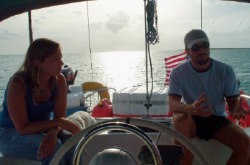
Chris and Margaret join us on Orion at Great Sale
Reconnecting
We were thrilled to get a surprise hail on the radio as we left Allans-Pensacola Cay from Lunasea. Chris and Margaret were ending their tour of the Bahamas and heading back to the states at the same time we were. We actually got to see them at Great Sale Cay and caught up on their travels over the past 6 months. They were planning to cross at the same time to Port Canaveral, so we agreed to stay in touch for the crossing. They returned our zinc grouper, which we had loaned them in Solomons – a well-traveled fish. Also, they told us we had to try fishing on the crossing, so they gave us a lure to help us catch something. Cathy was still a little less than excited about the gutting and cleaning process ( you need to let it bleed out in the cockpit), but maybe . . .
Why don't you write me?
Leaving Manjack Cay meant we were also leaving any means of communicating to anyone back home. Our internet connection was gone and we had no radio other than our VHF, which will only reach about 25 miles. This was worrying, since we weren’t able to communicate our plans to those back home before leaving. It also meant we were without any weather information for the crossing. Luckily, Sea Holly graciously offered to let our family know about our plans by sending an e-mail using their SSB radio. This was also the source of their daily weather updates from Chris Parker, which they shared with the rest of the group.
We knew about the SSB radio before we left, but also knew it could be pretty expensive to install. What we learned once in the Bahamas was that it was possible to get an SSB receiver for 1/10th the cost of a complete SSB set-up that allows transmissions. Also, Sea Holly was actually using a ham radio to get their SSB capability, which is much less expensive. It is also much easier to implement since April, when the ham radio license removed the morse code requirement from the certification test. We plan to look into more of these options if we decide to return to the Bahamas next year.
Next Stop – Florida
The next stop would be Port Canaveral, where many cruise ships use as a departure point. Hopefully, we could avoid their arrival times. . .
We were thrilled to get a surprise hail on the radio as we left Allans-Pensacola Cay from Lunasea. Chris and Margaret were ending their tour of the Bahamas and heading back to the states at the same time we were. We actually got to see them at Great Sale Cay and caught up on their travels over the past 6 months. They were planning to cross at the same time to Port Canaveral, so we agreed to stay in touch for the crossing. They returned our zinc grouper, which we had loaned them in Solomons – a well-traveled fish. Also, they told us we had to try fishing on the crossing, so they gave us a lure to help us catch something. Cathy was still a little less than excited about the gutting and cleaning process ( you need to let it bleed out in the cockpit), but maybe . . .
Why don't you write me?
Leaving Manjack Cay meant we were also leaving any means of communicating to anyone back home. Our internet connection was gone and we had no radio other than our VHF, which will only reach about 25 miles. This was worrying, since we weren’t able to communicate our plans to those back home before leaving. It also meant we were without any weather information for the crossing. Luckily, Sea Holly graciously offered to let our family know about our plans by sending an e-mail using their SSB radio. This was also the source of their daily weather updates from Chris Parker, which they shared with the rest of the group.
We knew about the SSB radio before we left, but also knew it could be pretty expensive to install. What we learned once in the Bahamas was that it was possible to get an SSB receiver for 1/10th the cost of a complete SSB set-up that allows transmissions. Also, Sea Holly was actually using a ham radio to get their SSB capability, which is much less expensive. It is also much easier to implement since April, when the ham radio license removed the morse code requirement from the certification test. We plan to look into more of these options if we decide to return to the Bahamas next year.
Next Stop – Florida
The next stop would be Port Canaveral, where many cruise ships use as a departure point. Hopefully, we could avoid their arrival times. . .
